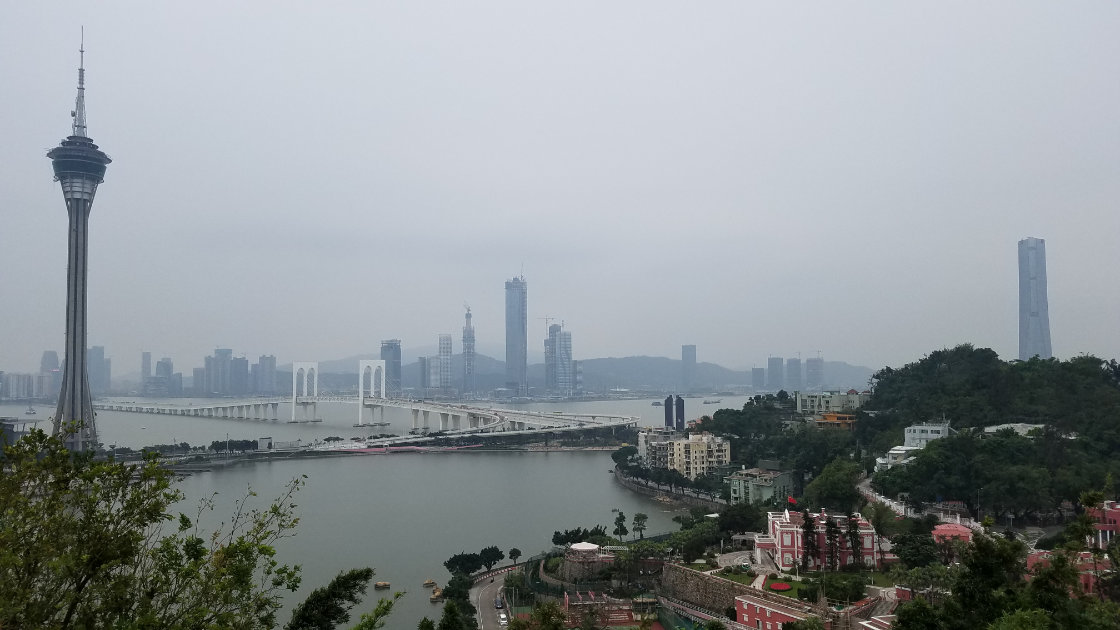

Empty houses line both sides of the street as we trek through São Lourenço, the parish that housed those who once ran Macau. An old town of expensive villas, government buildings and high temples & churches ambles purposefully across the scraggly hills — an original island of this infilling archipelago. Despite its historic grandeur, today we only feel the eerie emptiness of unlit windows, desolate streets and the occasional ruin.A As the houses grow in decadence, absent residents unveil their motives: the houses are 'offshore' investments — adrift between China and the rest of the world.B In one of the most densely populated places on the globe, many of these manors sit empty always, others fill only on extravagant weekends, but all keep a little bit of money away from the mainland and away from the masses. By no means are these investments safe, but hey, gambling has become what Macau is all about.


I have only second-hand knowledge of Las Vegas. Learning from, Fear and Loathing in, Leaving — each provides a disparate take on the watering hole of the Mojave. All from before I could read. To some, Vegas dazzles with drive-by delights and Strip signage; to others, the city frazzles with one-armed bandits and fly-by-nights. Like any good paragon of the postmodern era, it offers multiple conflicting narratives from a critical amassing of late-20th century capitalist artefacts. Las Vegas caters to the rags and the riches with claims of converts in both directions. But as capitalism progresses, so to do its cultural logics; Las Vegas becomes an outmoded model for our architecture today. Architects still learn from Rome (Venturi insists on Venice), so surely Vegas remains valuable;1 however, as generations pass, layers build up,2 and the Las Vegas from which we learned nearly fifty years ago no longer exists as either a place or an idea. After Las Vegas, what? From Venice to The Venetian, we proceed to to another, far grander Venetian.3,C

Macau, like its sibling across the Pearl River's estuary, has a complicated history of Sino-European interactions. Portuguese seafarers arranged the trading post around 1557, almost 300 years before the British would claim Hong Kong with opiate-addled force. With the establishment of a second European port in Guangdong, Macau faltered. Portugal no longer ruled the waves as it once did. Over the next hundred years, Macau stooped to trading slaves and using Portugal's neutrality in the war for economic endeavours — at least until their potential clients simply occupied them. Nothing returned Macau the purpose it once had, or at least nothing did until the 1960s, when its gambling industry began to take off. Macau slowly became the 'Las Vegas of the East,' and its entertainment industry today dwarfs Sin City's many times over. The Casino Lisboa, Macau's first casino, opened in 1970, two years before Venturi, Scott Brown and Izenour learned us. The Macau of today may as well have been a student in that fateful studio.
My travel companions on this Mecanese trip have both visited Vegas. One on business, the other for pleasure. Neither speaks highly of the city, and both actively dissuade me from a future visit — as non-architects, they see nothing of value there, especially not its tacky allure. "Why would you want to learn from that?" "Yeah, no thanks." I'll still go someday (if only to recreate Scott Brown's iconic photograph, defiant in the desert), but not without a risky skepticism towards Venturi et al's optimistic 'discovery.' The risk? They deride the architects who fail to see the value in what they analyze: "Indeed [such architects] find it difficult to concede any 'liberal' architect could do so."4 Their footnote makes clear that political affiliations do not interest them; they seek to outflank so-called ideologies in the game of intellectual progress. Time went with them. While 'liberal' architects stuck with a more Keynesian modernism, Venturi, Scott Brown and Izenour proposed a (dare I say it?) new liberalism for postmodern architecture, giving form to a new millenia of capitalism in its wake. Las Vegas sprang forth under the guise of financial excess — which certainly makes it an excellent study for the aesthetics and economics of postmodernity — but Macau provides insight into how its teachings act outside isolation.
Macau consists entirely of contrasting and complementary conditions. The flamboyance of Vegas adds only another layer to the city's complex history and architecture. Unlike other European colonists, the Iberians mixed. In this case, the city spawns from a marriage of Portuguese and Cantonese, both with a penchant for the sea. Pedestrian alleys downtown mix South Asian street markets with European winding walkways with their secret cafés.D Older urban villas mix Mediterranean and Asian courtyard strategies and materials into something not quite Catholic and not quite Confucian.E In fact, nothing is ever quite any one thing in Macau, but always both-and. No element remains pure, but never becomes unrecognizable from its assorted antecedents. Macau is a semblance of other places, an assemblage of similar yet antipodean spaces. Yet nothing solidifies enough to define a Mecanese identity. The mixture remains in motion; the whims of global events churn the city. Equilibrium evades. The ruins of St. Paul's showcase Macau's face without substance.5,F A typhoon and fire destroyed the Baroque building in the mid-19th century; only its bolstered facade still stands. There is no there there. Macau has worn so many masks that it no longer has its own face, and money rushes to fill in the void. The three major islands of the city dwindle to two; Taipa and Coloane merge with the formation of Cotai, five square kilometres / two square miles of sea reclaimed for casinos. Its neon signs light up the night, but no one is there to see them. Everyone is either already inside or has nothing to gamble.



I remember being infatuated the first time a professor had me read Venturi. It was neither Complexity and Contradiction or Learning from Las Vegas but his mother's house. What would strike most as a fairly banal (if not a little peculiar) exurban residence became a crash course in architectural discourse, but that's for another entry. Charles Jencks formulates this signifying as 'double-coding.'6 That is, postmodern architecture is to be read in two ways. On the one hand, it must offer the layperson a simple reading of aesthetic pleasure with, for example, a return to slightly more traditional forms. On the other, it offers the elite architect a number of in-jokes to the exclusion of everyone else. Rather than allowing misreadings to grow organically as they always will, postmodern architects split the world into those who already have and those who do not. Their architecture reinforces the world order that nurtured it: a free market once the cards have already been dealt. Such an economically motivated analysis provides us with a third code. First the layperson, then the all-too-pleased architect before everything begins to settle in, and now we see what has really been built.
Architecturally, culinarily and historically, Macau prospers across its extents. It profits financially too, but those riches are less dispersed. On a single street, tourists can see walls of either garish golden glass or barricaded balconies.G,H As the city entreats us to live a little with our wallets, its residents struggle to keep what they have — as too do its non-residents with their hillside villas. Those who live here do not flourish under Macau's current model of postmodern capitalism, but those who live in the mainland know they can take refuge in its protection of acquired wealth. China likely wishes to discontinue both outcomes. As China looks to rein in its Special Administrative Regions, Macau's fledgling identity of lugubrious luxury comes into question. Across the border, developments dwarf the high-rise casinos.I The delta closes in on the two Sino-European city-states. With Hong Kong's lack of interest in becoming China's economic launderer, Macau's future may move to gambling with other people's money in global finance. The loss of vice reduces the potency of the symbol (Learning from Wall Street, anyone?), but if the shoe fits, it may just be that it comes from the same cobbler. It is anyone's guess as to what will happen, but an uncertain place calls for uncertain times.



# Date [Return to] Title
500+ Ongoing Essays
550 May 2023 Platform Gamification
504 December 2022 On the Grid
518 December 2022 A Suspended Moment
A–Z Ongoing Glossary
G September 2022 – as in Girder
F May 2022 – as in Formal
* April 2022 – Key
E February 2022 – as in Entablature
D November 2021 – as in Duck
C August 2021 – as in Czarchitect
B June 2021 – as in Balustrade
A April 2021 – as in Aalto
0–15 December 2020 Journal
15 November 2020 Practice (in Theory)
14 October 2020 Alternative Narratives beyond Angkor
13 September 2020 Urban Preservation in Cuba
12e August 2020 Conversation on Copley Square: Summations
12d July 2020 Conversation on Copley Square: Conceptions
12c June 2020 Conversation on Copley Square: Reflections
12b June 2020 Conversation on Copley Square: Nonfictions
12a May 2020 Conversation on Copley Square: Foundations
11 May 2020 Out of OFFICE
10 March 2020 Hudson Yards from the High Line
9 March 2020 Metastructures
8 February 2020 Form, Program and Movements
7 February 2020 Life in the Ruins of Ruins
6 January 2020 The Urban Improvise
5 January 2020 Having Learned from Las Vegas, or Moving past Macau
4 December 2019 A Retrospective on the Decade's Spaces
3 December 2019 The Captive Global City
2 November 2019 Temporal Layers in Archaeological Space
1 November 2019 Contemporary Art Museums as Sculptures in the Field
0 Undated Manifesto: A Loose Architecture
© 2019 – 2023 Win Overholser
Comments
Loading comments...
Powered by HTML Comment Box.